
On your healthy breast journey, there are dozens of modalities you can choose from that can have a place in your healing toolbox. Some of them target specific mechanisms for the most part, such as sulforaphane from broccoli sprouts, Turkey Tail to inhibit cancer cells, or iodine to support the thyroid. Some modalities, however, have a sweeping effect. They help the body on all levels for repair and optimal function. Red light therapy is a modality that helps the body on many levels. Come with me as I take you on a tour of the light spectrum and show you how red light therapy (RLT) can help your whole body!
The Light Spectrum
First, let’s start with the basics. There is more to the substance called “light” than what you see when you switch on a lightbulb or go outside on a sunny day. In fact, the kind of light that we can see with our physical eyes is very limited. It represents only a tiny fraction of what exists. According to NASA, the human eye is only able to detect light waves of between 380 to 700 nanometers. The color violet represents the shortest wavelength that we are able to see at 380 nanometers. Red light has the longest visible wavelength at around 700 nanometers.
But what about the rest?
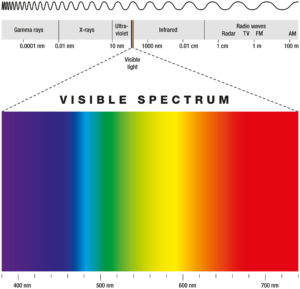
The entire spectrum actually goes from 10-5 nanometers in the form of gamma rays beyond violet to 103 meters in the form of radio waves. On the gamma-ray side of the spectrum, there is x-ray light and ultraviolet light. On the radio wave side, there is near-infrared light, infrared light, and microwave.
Light Affects Humans
Much of this “invisible to the naked eye” light is damaging to our human bodies. X-rays, for example, can damage us with radiation. Most EMF waves, which also fall near the blue end of the spectrum and are emitted from our cell phones and Wi-Fi routers, are also on the blue end. Microwave light frequencies do more than warm up our food. In fact, some evidence suggests that microwaves are bad news because the light that comes from them can damage DNA.
On the other hand, there are forms of light that can be very beneficial for human health. For example, visible blue light can be stimulating in a good way in small amounts. Blue light can increase cellular respiration and activate the enzyme telomerase, which helps with longevity. Yellow light can kickstart serotonin levels and help with vitamin D metabolism. Greenlight is said to oxygenate the blood and help the heart.
The fact that different frequencies of light can actually affect the human body is nothing new, and it’s not just woo-woo fluff either. Even conventional medicine has been relying on light therapy in various ways for decades. Ultrasound testing, x-ray machines, and photodynamic therapy (PDT) for chemotherapy treatment are all examples of this.
The Benefits of Red Light Therapy
Forms of light that are beneficial to human health are where red light, near-infrared light, and red light therapy (RLT) come into play. Besides “red light therapy,” you may have heard of this modality by other names such as RLT, soft laser therapy, photonic stimulation, cold laser therapy, low-level light therapy, low-power laser therapy, bio-stimulation, and photo-biomodulation.
Scientists first turned their attention to the potential benefits of red light for healing when astronauts discovered that putting plants under red light-emitting LEDs helped the plants grow in space. That was in the early 1990s. Later studies discovered how red-light therapy can have vast benefits for cellular health throughout the whole body. Red light therapy strengthens cellular mitochondria, helping cells to become more efficient at creating energy in the form of ATP. More efficient energy conversion means that the body is able to repair faster and operate at a higher capacity on all levels.
Among the benefits of red-light therapy are:
#1 Helps Circadian Rhythm.
Red light can help you sleep better by improving the circadian rhythm and increasing the production of melatonin. There have actually been quite a few studies to support this connection. A 2012 trial on female athletes found that 30 minutes of red light therapy every night for just 14 days resulted in improved sleep quality, more balanced melatonin levels, and better endurance in athletic events. Red light itself apparently doesn’t make you sleepy but instead helps to balance circadian rhythms so that you have energy when you are supposed to according to your internal clock. Another short 3-week study found that people in an office setting who worked in an environment where there was both red light and ambient white light had more alertness after lunch.
#2 Rejuvenates the Endocrine System.
RLT helps metabolism at the mitochondria level. This has a cascading effect of benefits for all chemical communications and functions within the endocrine system. According to functional medicine doctor and licensed therapist, Dr. Kelly Gibas, “[a]mong, the key feature of metabolic pathology is ‘stiffness’ in mitochondrial substrate selection.” RLT helps loosen up that stiffness within cells to get hormonal communication and production flowing again. RLT has been shown to promote balance systematically when it comes to hormones. This can result in healing for the thyroid, reproductive organs, and more.
#3 Good for the Liver.
RLT helps reduce oxidative stress, which can greatly support the liver as well as all avenues of detoxification. 2009 in vivo study conducted at the University of Indiana found that light therapy using 670 nm photo-biomodulation reduced acute hepatic stress (caused by oxidative stress) and also kickstarted the body’s intrinsic antioxidant defense system in rats with diabetes.
#4 Lowers Inflammation.
Just like all the other “necessities” of a healthy life such as good sleep, moving your body, and eating a whole foods diet, being exposed to healthy forms of light can also help reduce inflammation. A recent paper put out by Harvard researcher Dr. Michael Hamblin found that RLT can reduce levels of RNS (reactive nitrogen species) and can reduce inflammation specifically in the “brain, abdominal fat, wounds, lungs, [and] spinal cord.” Wow!
#5 Helps with Collagen Production.
Red light therapy helps to boost cellular health in the skin and internal tissues through the way that it can boost collagen production. A 2014 German study found that full-body red light therapy treatment led to higher collagen levels intradermally. The participants in the study also noticed “significantly improved skin complexion and skin feeling” as well as less skin roughness and higher measured collagen density overall.
#6 Reduces Pain.
One of the most proven and well-known benefits of red-light therapy is what it can do to reduce pain. This is such a vibrant focus of study at the moment that the University of Arizona is currently conducting clinical trials around the subject (no results posted yet). Past studies have definitely proven its efficacy in this regard. A 2017 joint meta-analysis conducted in part by Bern University of Applied Sciences in Bern, Switzerland of close to 20 other studies found evidence that RLT can significantly reduce pain in adult patients with musculoskeletal disorders.
#7 Improves Dental Health.
Red light therapy increases circulation on all levels and also helps to produce healthy stem cells, as I mentioned earlier. This can have a profound effect on your oral health. In similar ways to how RLT can improve skin and remove wrinkles (RLT for beauty is not the focus of this article, but it really can help in this regard!), RLT can also help rejuvenate the tissue around your gums. This can lead to the removal of pathogenic bacteria, lower inflammation in the mouth, and less pain. Small studies have also indicated that RLT can help reduce pain caused by TMD (temporomandibular dysfunction syndrome).
#8 Helps the Blood.
I already talked a little bit about how red light strengthens cellular mitochondria. This one characteristic really boosts and strengthens metabolism. One way RLT does this is by activating different enzymes that help to increase oxygen levels in the blood. Increased blood oxygenation helps cleanse the blood, remove toxins, and have a whole host of other positive effects.
#9 Boosts Healthy Stem Cell Production.
RLT also helps boost healthy stem cell production. Why is this important? Stem cells are light blank slate cells. They will go where they are needed and can “become” a healthy lung cell, a heart cell, or a GI tract cell. They can even become brain cells! One 2018 Israel study found that light therapy helped to stimulate stem cells needed to regenerate and heal after myocardial infarction.
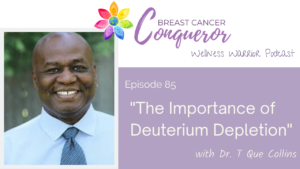
#10 Helps with Deuterium Depletion.
Last year I posted a podcast with Dr. T Que Collins about the importance of deuterium depletion for breast cancer and overall health. It is a fascinating subject because deuterium and its significance for the body is such an obscure topic. Deuterium is also called “heavy hydrogen”. Having too much of it in your system may be one of the causes of autoimmune, diabetes, and even cancer. RLT has been shown to help with deuterium depletion. According to experts, the way it works is that when our bodies absorb red and near-infrared light waves (600-950 nm), our cells become less “sticky” and cellular respiration improves. Again, it comes down to the amazing things that RLT can do to help our cellular mitochondria!
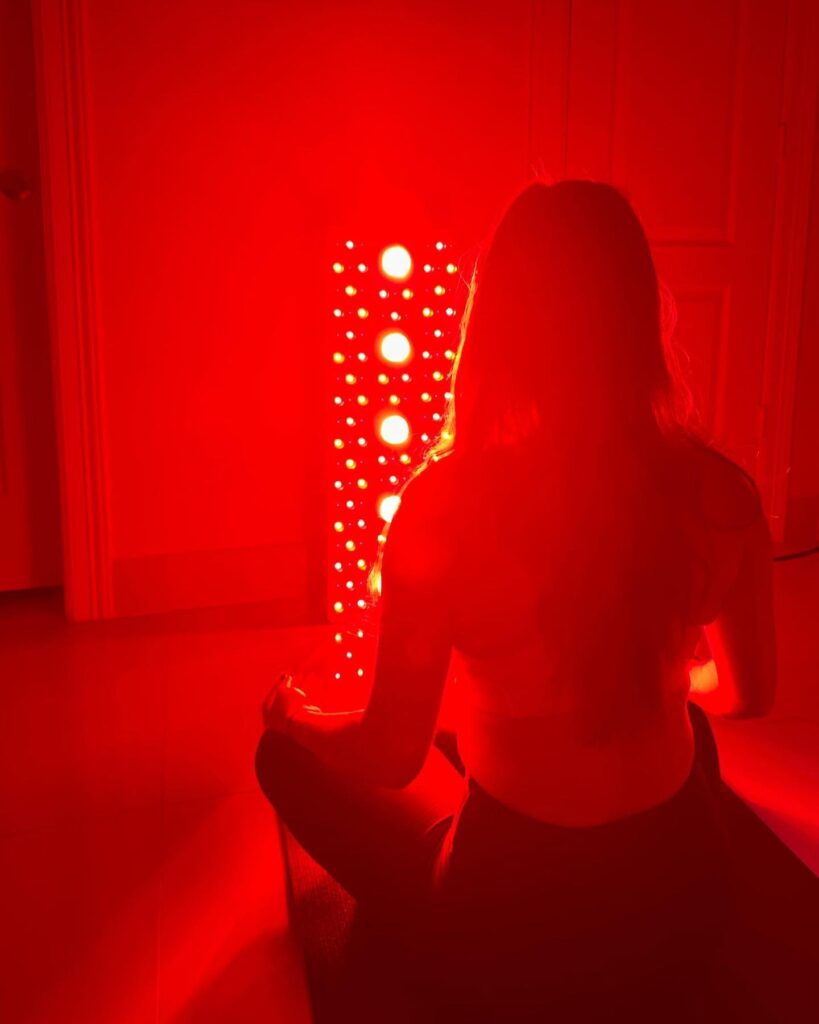 How Do You Use Red Light Therapy?
How Do You Use Red Light Therapy?
Red light can be used in various ways, depending on your needs. After years of extensive research, my favorite source for red light therapy devices is EMR-TEK. They offer the latest state-of-the-art technology in RLT yet keep it affordable, too! I use the FIREWAVE and love its innovative design, which offers a low flicker rate and unparalleled irradiance intensity. Check out all of EMR-TEK‘s offerings including EMF protection, blue light glasses, and indoor lighting solutions.
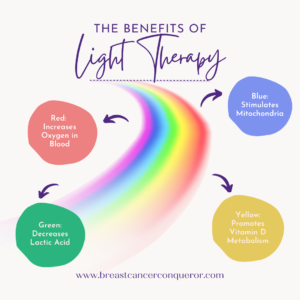
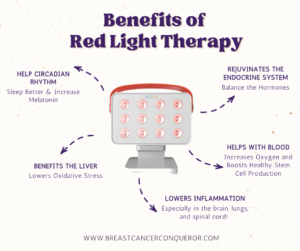

Can this info be put in a podcast?
Yes…. Dr V will be doing a Facebook Live and a webinar in the near future…. stay tuned for dates!
I have a red light therapy unit from http://redtherapy.com , a panel of both red and near-infrared lights that can be turned on separately or at same time, about 12″ X 18″ . I really don’t know the optimum way to use it. I can hang it on the door and try to expose different body parts to it, or I can concentrate it on my breast. The general instructions say 1. for general health , place 2 feet away for 5 min per area 2.Deep tissue, 6″ away for 10 min 3. Skin , place 3 feet away for 10 min. How are others using red light therapy to treat breast cancer ? Can you determine any results?
Infrared is just one piece of the puzzle to aid and assist the body. The frequency exposure is one helpful part and sweating is another important component. I would call the company to ask what they have found to be true.
Is there any concern about red light therapy impact on atp production and actually creating cell growth in tumor cells?
Here are two things to check out! https://support.joovv.com/article/244-what-are-the-contraindication-and-precautionary-warnings https://pubmed.ncbi.nlm.nih.gov/32654094/